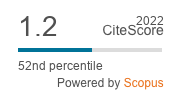The impact of technologies on early childhood leisure
DOI:
https://doi.org/10.12795/revistafuentes.2021.12753Keywords:
ICT, leisure, early childhood, families, free time, enjoyment, recreational learninngAbstract
In recent years, a great increase in the importance of Information and Communication Technology (ICT) during early childhood leisure time has been noted. In this context, it is necessary to pay attention to the role of families in order to regulate their use, becoming the main responsible for guiding children to prevent their risks and benefit from their potential. This project aims to recognize the impact of ICT in leisure activities during 3-6 years old children’s free time in a town of . According to this aim, an ad hoc questionnaire is used to collect the information provided by 149 families selected through a non-probabilistic sampling of an incidental type. The results show that activities which use the technological support are configured as a fundamental pillar of children's leisure time, being enjoyment and recreational learning the main purposes considered by families when exposing their children to ICT. The conclusions point to the need of making parents aware of their importance as modelers of the technological use developed by their children, providing them with some keys to undertake this task effectively.
Downloads
References
Albert, M. J. (2007). Aspectos fundamentales sobre investigación (E. M. Albert, Ed.). La: McGraw-Hill. Álvarez, E., y Alejaldre, L. (2019). Las TIC como mediadoras en el aprendizaje de lenguas extranjeras en
Educación Infantil. Aproximación desde el enfoque natural. Tejuelo(30), 175-206.
Alvarez-Pitti, J., Casajús-Mallén, J. A., Leis-Trabazo, R., Lucía, A., de Lara, D. L., Moreno-Aznar, L. A., y Rodríguez-Martínez, G. (2020). Ejercicio físico como «medicina» en enfermedades crónicas durante la infancia y la adolescencia. Anales de Pediatría, 92(3), 173.e1-173.e8. Retrieved from https://dx.doi.org/10.1016/ j.anpedi.2020.01.010 10.1016/j.anpedi.2020.01.010
Cánovas, G., García, A., Oliaga, A., y Aboy, I. (2014). Menores de Edad y Conectividad Móvil en España: Tablets y Smartphones. Centro de Seguridad en Internet para los Menores en España: Protégeles. Retrieved from https://bit.ly/339oVtf
Carrillo, S. C. (2015). Infancia y Socialización Mediática: el papel de las Tecnologías de la Información y la Comunicación (TIC) en la socialización de un grupo de niños y niñas de 5 y 6 años de edad. Retrieved from https://bit.ly/30gF26g
Cepal, N., y Unicef. (2016). El derecho al tiempo libre en la infancia y adolescencia. Desafíos: Boletín de la infancia y adolescencia, 19, 1-12. Retrieved from https://bit.ly/3hTa4qR
Chaudron, S., Gioia, R. D., y Gemo, M. (2018). Young Children (0-8) and Digital Technology. A qualitative study across Europe. European Union. Retrieved from http://doi.org/10.2760/294383%20
Cruz, M. A., Pozo, M. A., Aushay, H. R., y Arias, A. D. (2019). Las Tecnologías de la Información y de la Comunicación (TIC) como forma investigativa disciplinaria con un enfoque intercultural para el proceso de formación estudiantil. e-Ciencias de la Información, 9(1), 2-15. Retrieved from https://doi.org/10.15517/ eci.v1i1.33052
de Estadística., I. N. (Ed.). (2019). Encuesta sobre Equipamiento y Uso de Tecnologías de Información y Comunicación en los Hogares. Retrieved from https://bit.ly/2Pbdd9p
de la Rosa, O. M. A., y Angulo, L. M. V. (2019). Análisis factorial de las actitudes de niños de 6 a 16 años con dispositivos auditivos hacia la educación inclusiva. Aula Abierta, 48(2), 129-129. Retrieved from https://dx.doi.org/10.17811/rifie.48.2.2019.129-138 10.17811/rifie.48.2.2019.129-138
de-la Salud, O.-M. (2019). Guidelines on physical activity, sedentary behaviour and sleep for children under 5 years of age. Retrieved from https://bit.ly/312eB3y
de Pediatría., A. A. (Ed.). (2016). Media Use in School-Aged Children and Adolescents. Pediatrics, 138(5), 1-6. de Tecnologías Educativas y de Formación del Profesorado, I. N. (Ed.). (2016). Uso de las tecnologías por niños de hasta ocho años. INTEF. Retrieved from https://bit.ly/3jYkF5L
Díaz, R., y Aladro, M. (2016). La relación entre uso de las nuevas tecnologías y sobrepeso infantil, como problema de salud pública. RqR Enfermería Comunitaria, 4(1), 46-51.
Espinoza-Santacruz, F. J., y Flores-Urgiles, C. H. (2019). Aplicación de tecnologías de la información en el desarrollo del lenguaje de niños con dificultades de comunicación. Polo del Conocimiento: Revista Científico Profesional, 4(5), 116-116. Retrieved from https://dx.doi.org/10.23857/pc.v4i5.968 10.23857/pc.v4i5.968 Feijóo, B. (2015). La infancia ante las pantallas: análisis del consumo de medios audiovisuales (TV, videojuegos e internet) entre los niños gallegos del último curso de primaria en 2010. Retrieved from https://bit.ly/362fuwX Fernández, A. (2017). Las nuevas tecnologías en la primera infancia. Retrieved from https://bit.ly/3hXZU8j GAD3. (2018). Retrieved from https://bit.ly/3hT85CV
Garmendia, M., Jiménez, E., Casado, M. A., y Mascheroni, G. (2010). Net Children Go Mobile: Riesgos y oportunidades en internet y el uso de dispositivos móviles entre menores españoles. Red.es/Universidad del País Vasco/Euskal Herriko Unibertsitatea.
Gjelaj, M., Buza, K., Shatri, K., y Zabeli, N. (2020). Digital Technologies in Early Childhood: Attitudes and Practices of Parents and Teachers in Kosovo. International Journal of Instruction, 13(1), 165-184.
Hernández, R., Fernández, C., y Baptista, P. (2006). Similitudes y diferencias entre los enfoques cuantitativo y cualitativo. Metodología de la Investigación, 1-30.
Hernández, R., Fernández, C., y Baptista, P. (2007). Definición del alcance de la investigación a realizar: Exploratoria, descriptiva, correlacional o explicativa. En R. Hernández, C. Fernández & P. Baptista, Fundamentos de metodología de la investigación, 57-72.
Labrador, F., Requesens, A., y Helguera, M. (2015). Guía para padres y educadores sobre el uso seguro de Internet, móviles y videojuegos. Fundación Gaudium. Retrieved from https://bit.ly/2Xi2yy6
Las nuevas tecnologías en niños y adolescentes. Guía para educar saludablemente en una sociedad digital. (2015). In G. Roca (Ed.), . Hospital Sant Joan de Déu. Retrieved from https://bit.ly/3fg9Bxe
L’ecuyer, C. (2017). Educar en el asombro. Plataforma Editorial.
León-Llorente, C. (2020). Robotización, ¿solo cambiará el empleo? Revista empresa y humanismo, 23(1), 9-33. Retrieved from https://doi.org/10.15581/015.xxiii.1.9-33
López-Castro, L., Núñez, J., y Cambeiro, M. C. (2019). Medición parental del uso de Internet: Una estrategia educativa para minimizar los riesgos de la infancia. In G. d’Investigació i Formació Educativa i Social (Ed.), Congreso Internacional SIPS: “Pedagogía social, investigación y familias” (p. 59-68). Retrieved from https:// bit.ly/3kHytkJ
López-Cirugeda, I., y López-Campillo, R. M. (2016). El método sistemático-sintético de lectoescritura Phonics como herramienta para la adquisición de la fonética inglesa. Revista Fuentes, 18(2), 183-195. Martínez-Pastor, E., Catalina-García, B., y de Ayala-López, M.-C. L. (2019). Smartphone, menores y vulnerabilidades. Revisión de la literatura. Revista Mediterránea de Comunicación, 10(2), 257-268. Retrieved from https://dx.doi.org/10.14198/medcom2019.10.2.5 10.14198/medcom2019.10.2.5
Muñoz-Borja, P., García-Ruiz, R., y Aguaded, I. (2020). La educomunicación en la documentación pública, privada y académica colombiana en su compresión de la cuestión social. Revista Fuentes, 1(22), 1-12. Retrieved from https://dx.doi.org/10.12795/revistafuentes.2020.v22.i1.01 10.12795/revistafuentes.2020.v22.i1.01 Paniagua, H. (2018). El impacto de las pantallas: televisión, ordenador y videojuegos. Pediatría Integral, 22(4), 178-186.
Pérez, A. (2018). Uso de smartphones y redes sociales en alumnos/as de Educación Primaria. Prisma social, 20, 76-91. Retrieved from https://bit.ly/2G1LYN0
Prensky, M. (2001). Digital Natives, Digital Immigrants. On the Horizon, 9(5), 1-6. Retrieved from https://bit.ly/ 2RSCIxm
Quiroga, L. P., Vanegas, O. L., y Pardo, S. (2019). Ventajas y desventajas de las tic en la educación “Desde la primera infancia hasta la educación superior”. Revista de educación y pensamiento, 26, 77-85. Retrieved from https://bit.ly/33TT1zK
Ramírez-García, A., Salcines-Talledo, I., y González-Fernández, N. (2020). Los dispositivos móviles en el hogar. Interés formativo de las familias españolas. REOP - Revista Española de Orientación y Psicopedagogía, 31(1), 43-43. Retrieved from https://dx.doi.org/10.5944/reop.vol.31.num.1.2020.27286 10.5944/reop.vol.31.num .1.2020.27286
Rojo, T., y Dudu, S. (2017). Los “juegos serios” como instrumentos de empoderamiento y aprendizaje socio- laboral inclusivo.
Sáez, J. M. (2017). Investigación educativa. Fundamentos teóricos, procesos y elementos prácticos. UNED. Serna-Rodrigo, R. (2020). Posibilidades de los videojuegos en el ámbito de la Didáctica de la Lengua y la Literatura. EDMETIC. Revista de Educación Mediática y TIC, 9(1), 104-125.
Sivrikova, N. V., Ptashko, T. G., Perebeynos, A. E., Chernikova, E. G., Gilyazeva, N. V., y Vasilyeva, V. S. (2020). Parental reports on digital devices use in infancy and early childhood. Education and Information Technologies, 25, 3957-3973. Retrieved from https://dx.doi.org/10.1007/s10639-020-10145-z 10.1007/s10639-020-10145-z Soto, A., De-Miguel, N., y Pérez, V. (2018). Abordaje de adicciones a nuevas tecnologías: Una propuesta de prevención en contexto escolar y tratamiento de rehabilitación. Papeles del Psicólogo, 39(2), 120-126. Retrieved from https://doi.org/10.23923/pap.psicol2018.2867
Takacs, Z. K., Swart, E. K., y Bus, A. G. (2015). Benefits and Pitfalls of Multimedia and Interactive Features in Technology-Enhanced Storybooks. Review of Educational Research, 85(4), 698-739. Retrieved from https:// dx.doi.org/10.3102/0034654314566989 10.3102/0034654314566989
Turk, V. (2018). Entendiendo a la Generación Alfa. Hotwire, The Global Communications Agency. Retrieved from https://bit.ly/3ggfwE3
Unicef. (2014). Acompañando a los nativos digitales. Retrieved from https://bit.ly/3164UB6
UNICEF. (2017). Niños en un mundo digital. El estado mundial de la infancia 2017. Retrieved from https:// doi.org/10.18356/fb1d52cf-es
UNICEF. (2018). Niños, niñas y adolescentes conectados: Informe Kids Online Uruguay. Retrieved from https://bit.ly/2PlLrXv
Published
How to Cite
Issue
Section
License
Copyright (c) 2021 Revista Fuentes

This work is licensed under a Creative Commons Attribution-NonCommercial-ShareAlike 4.0 International License.
Authors who publish in this journal accept the following conditions:
Authors conserve the copyrights and cede to the journal the right for first publication, with the work registered with the attribution licence of Creative Commons, which allows third parties to use the published work as long as they mention the authorship and the first publication in this journal.
The authors may make other independent and additional contractual agreements for the non-exclusive distribution of the version of the article published in this journal (e.g. include it an institutional repository or publish it in a book) as long as it clearly indicates that the work was first published in this journal.
Authors are allowed and indeed recommended to publish their work on the internet (for example on institutional or personal pages) before and during the revision and publication process, because it can lead to productive exchanges and greater and faster dissemination of the published work (see The Effect of Open Access).
Accepted 2021-03-29
Published 2021-05-16
- Abstract 4688
- PDF (Español (España)) 2105
- HTML (Español (España)) 1131
- EPUB (Español (España)) 77















